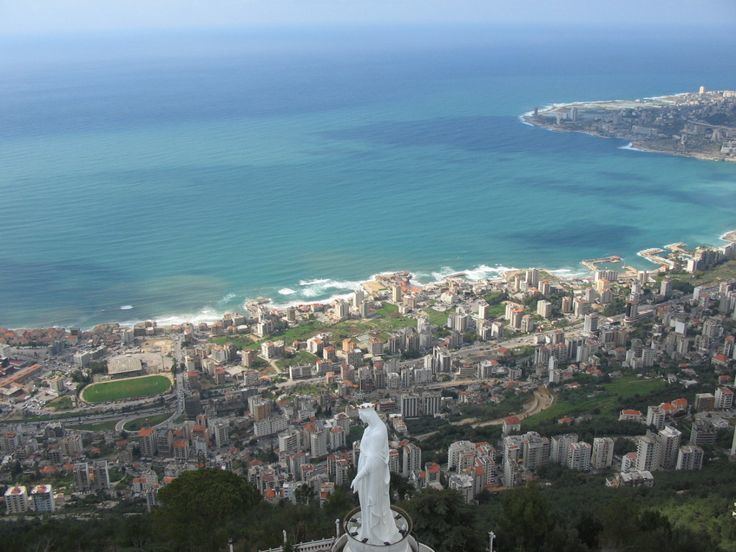Dialing code +961 Area 4.35 km² Area code +961 | Governorate Mount Lebanon Time zone EET (UTC+2) Elevation 550 m Local time Thursday 10:06 PM | |
 | ||
Weather 11°C, Wind S at 16 km/h, 65% Humidity | ||
Harissa-Daraoun (Arabic: حريصا–درعون) is a municipality that consists of two villages, Harissa and Daraoun, in the Keserwan District of the Mount Lebanon Governorate of Lebanon. The municipality is located 27 km north of Beirut. Its average elevation is 550 meters above sea level and its total land area is 435 hectares. Harissa is accessible from the coastal city of Jounieh either by road or by a nine-minute journey by a gondola lift, known as the Téléphérique. Harissa is home to an important Lebanese pilgrimage site, Our Lady of Lebanon. It attracts both pilgrims and tourists who want to enjoy views of the bay of Jounieh.
Contents
Map of Harissa, Lebanon
Daraoun contains three schools, one public and two private, that enrolled a total of 457 students as of 2008, while Harissa had one public school with 242 students during that same time period. There were eight companies with over five employees operating in Daraoun as of 2008, and two companies with over five employees in Harissa during that same period. Daraoun's inhabitants are predominantly Maronite Catholics, while Harissa has a mixed population of Melkite and Maronite Catholics.
Founding
Harissa is a key Christian pilgrimage site with a shrine dedicated to Our Lady of Lebanon (Notre Dame du Liban). In 1904, Patriarch Elias Hoyek, on the 50th anniversary of the proclamation of the Dogma of the Immaculate Conception, announced the foundation of the building of Our Lady of Lebanon. The shrine belongs to the Maronite Patriarchate who entrusted its administration to the Congregation of Maronite Lebanese Missionaries since its foundation in 1904. The original church was built by Sleiman Yakoub Hokayim from Batrun. The mountain is called Harissa (after the village at the peak of the mountain). When it was inaugurated in 1908 the Patriarch dedicated Lebanon to the Virgin Mary: "Oh Mary, Queen of mountains and seas and Queen of our beloved Lebanon ...” Patriarch Hoyek designated the first Sunday in the month of May as the Feast of Our Lady of Lebanon. On this day the Maronite Patriarch and all the Lebanese Bishops celebrate the Divine Liturgy in the open air at the Shrine of Our Lady of Lebanon.
Our Lady of Lebanon is one of the most important shrines in the world honoring the Virgin Mary. The shrine is highlighted by a huge, 15-ton bronze statue of the Immaculate Conception, Mother of God. It is 8.5 m high, and has a diameter of five meters. The Virgin Mary stretches her hands towards Beirut. The shrine of Our Lady of Lebanon draws millions of faithful both Christians and Muslims from all over the world. The 50th jubilee in 1954 was also the hundredth anniversary of the establishment of the Immaculate Conception. During these Jubilee celebrations, Pope Pius XII sent his representative, Cardinal Angelo Roncalli to Lebanon, the later Pope John XXIII. Pope John Paul II visited Our Lady of Lebanon in 1997. The Congregation of Maronite Lebanese Missionaries, responsible for the administration, works at reinforcing relations among all local Churches, Christian communities and apostolic movements.
Religious significance
]
The pilgrimage site there is a large, 15-ton bronze (and painted white) statue of Virgin Mary, known as Our Lady of Lebanon or Notre Dame du Liban, with her arms stretched. The statue was made at the end of the 19th century and inaugurated in 1908, on land donated by the noble Maronite Khazen clan. Inside the statue's base, there is a small chapel. A huge Brutalist Maronite cathedral built of concrete and glass stands adjacent to the statue.
Among other churches of various Christian denominations in the vicinity of Harissa are the Byzantine-style, Melkite Greek Catholic basilica of St. Paul, located south of the statue and built between 1948 and 1998, the Apostolic Nunciature (Papal Embassy), as well as the residences of four patriarchs of Eastern Catholic Churches.
On 10 May 1997, Pope John Paul II visited Harissa. On 15 September 2012, Pope Benedict XVI visited Harissa, including a visit to Our Lady Of Lebanon.
